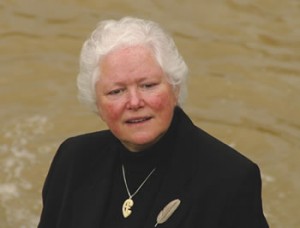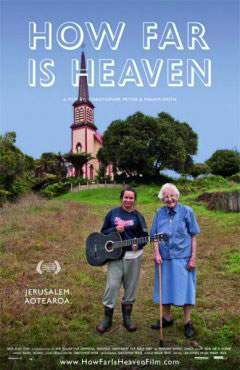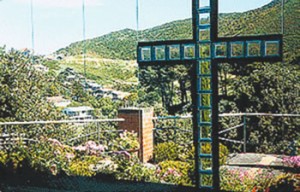Sr Sue Cosgrove DOLC
 With regard to the feature film How Far is Heaven? by Miriam Smith and Christopher Pryor, 2012.
With regard to the feature film How Far is Heaven? by Miriam Smith and Christopher Pryor, 2012.
MM Sister, how did you come to feature in this documentary picture about the village of Hiruharama (Jerusalem) on the Wanganui River?
Sue Miriam Smith approached us about the possibility of a documentary. Miriam had been to Jerusalem a number of times over many years and felt there was a story to be shared. She and Chris spent 12 months getting to know the whole community – engendering trust and confidence and we all finally agreed to having a documentary filmed. It became a relatively ‘easy’ process, very unobtrusive and unwittingly bought our community of Sisters freshly in tune with the ‘now’, the everyday comings and goings.
MM How long were you posted at Jerusalem this time?
Sue I lived at Hiruharama for about 10 years. I first went to Jerusalem as a young novice and discovered a deep connection with the people and the place within myself. A wonderful blessing.
MM You said on the film that you were there “to keep our story alive”. Can you just unpack that a little.
Sue Suzanne Aubert’s Jerusalem has been home to the Sisters of Compassion since 1892. Because of our long association with Ngati Hau and Ngati Ruaka, Hiruharama is our turangawaewae. In the earlier days the Sisters were everything for the people – Teachers. Nurses, Midwives, Social Workers – the people went where the Sisters lead them. Today we Sisters go where the people lead us. Suzanne Aubert reminds us to:
“Never forget...a Maori village was the cradle of our Institute.”
And Suzanne wrote to one of the Sisters whilst she was in Rome, she said: “I often wander in spirit about Jerusalem, Ranana and the mission. Oh! O I love it dearly. I pray every day for it and for the Sisters employed in it. The softest corner of my heart is always amongst the Maoris. It was for them I left home fifty six years ago.” Jerusalem is who we are…
MM Your cooking was greatly appreciated in the film. Do you feel now that it was worth the effort?
Sue Oh yes!! I didn’t know that, like my Mother, I was born to be a homemaker! To be inspired to use the fruit of the land (for the first time I was living in a place with grapefruit at the front door! Heritage plum and apple trees a few metres away) to look for ways to live a more sustainable lifestyle and to help others do the same. I loved working with the younger women and it is a great joy to know that they continue with jam making!
MM: One remark about the film was a scarcity of parents around the children. Were they kept away from the camera for a reason? Was it a film just about the sisters and the children?
Sue: Oh - there is no scarcity of parents - they are there on the side-line and they needed to sign agreements to have their children involved in the film. The editing and post-production phase of the film was a challenge, as Miriam and Chris had over 400 hours of footage. The more folk actually in a film the more complex it becomes, hence the decision to focus on the children and the Sisters. One of my most enduring memories of Hiruharama is of being with the parents and children and watching as relationships developed and as they all cared for one another, especially on the Marae and in the river!
MM The market in town was a focal point of life. In what way?
Sue The River Traders Market, in Whanganui, was founded in Autumn of 2005. Annette Main’s mission was to have a place where people could sell/exchange organic produce and other goods. The idea was also to have a place where people could meet to chat and socialise. Annette was inspired by the area’s history – in early colonial days it was where Whanganui River people beached their waka and sold/ exchanged food they had raised or hunted further up the river. On a personal note the Market Place, in its ordinariness, reminded me again of God being “in all things”. There is a beauty and grace about the Market Place that is rich in every way. Sometimes tiredness, distraction or haste can really get in the way; however, a morning at the Market Place always bought me a fresh perspective.
MM. In earlier times, you met poet and social prophet James K. Baxter at Jerusalem. What is your best memory of him?
Sue It was very exciting as an 18 yr old novice to go to our “roots up the river!” It was in 1969, my second visit, that I met Jim Baxter – this bearded, seemingly old, man with rosary beads in his hand, walking towards the Church. I so enjoyed listening to him. At every opportunity he was open to having a conversation! I began reading more of his poetry – especially Jerusalem Day Book and Jerusalem Sonnets for Colin Durning. I really appreciated his spirituality of “place” – by reading these works you get a feel for the landscape of the river and surrounding areas. I will always be grateful for those times that continue to sustain me.
MM You said that at a deep level the villagers ‘do not need us’. Some of them might disagree. What do you say to them?
Sue We Sisters are an aging group – we don’t have the human resources we had a few decades ago. We do want to continue living at Jerusalem to be with the younger ones as they constantly weigh up opportunities for a sustainable lifestyle. To encourage them as they learn new skills (gardening, firearms licences, farming skills) from the more mature members. To join in their enthusiasm as they search out business ventures and support their studies for a Certificate in Small Business Management and Tourism Maori.
It is a struggle – confidence doesn’t come naturally. We all take one step forward and one back….there are always pressures to conform, to be accountable, to get “proper” employment. All the while deepening one’s sense of who you are and where you belong.
MM. Do you miss the beauty of Hiruharama in its different seasons as shown in the feature film?
Sue Yes- I do miss Hiruharama. However, it doesn’t take much effort to hear and sense all that Jerusalem gifted me with, at Island Bay!
 Entries(RSS)
Entries(RSS)